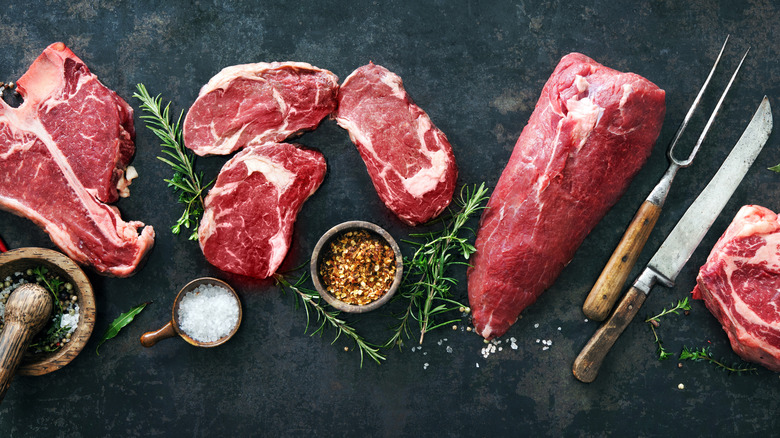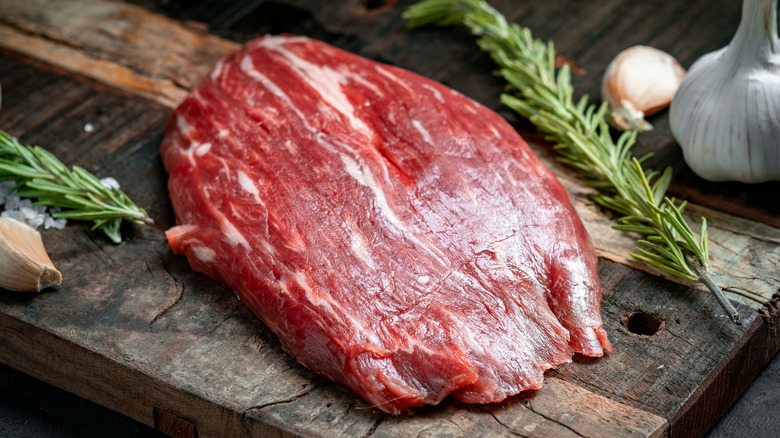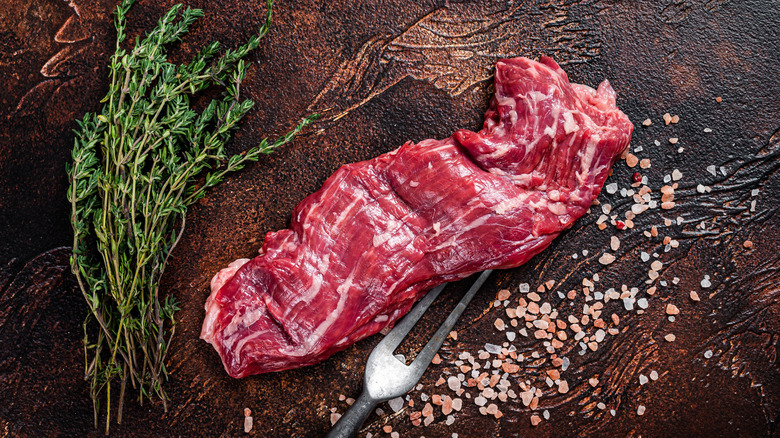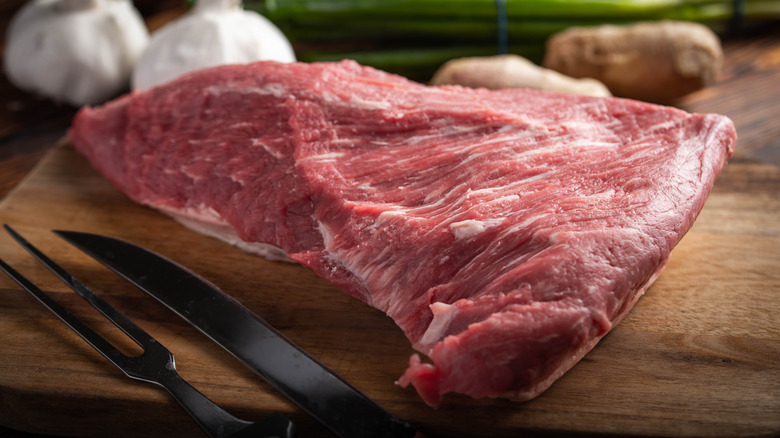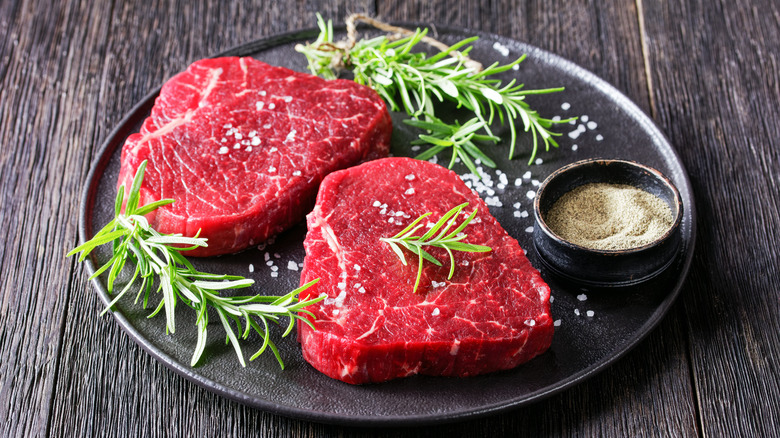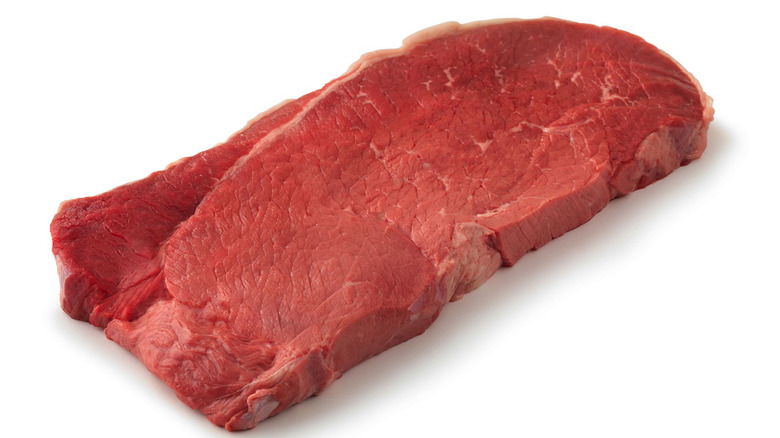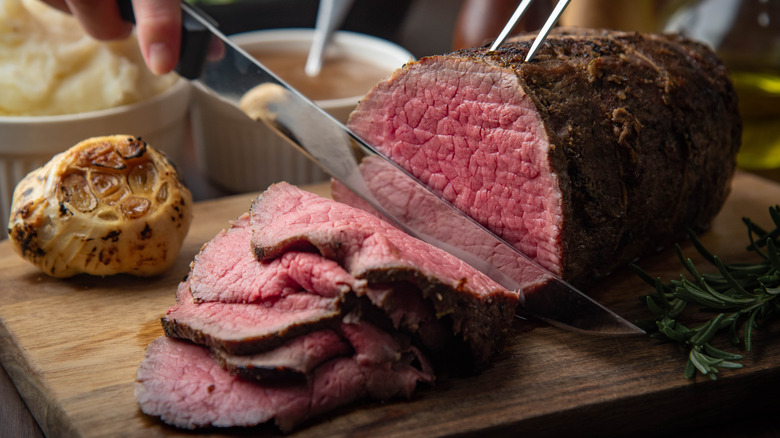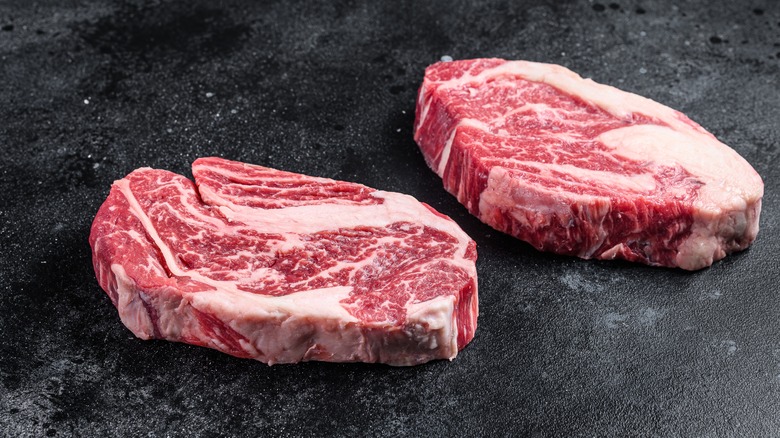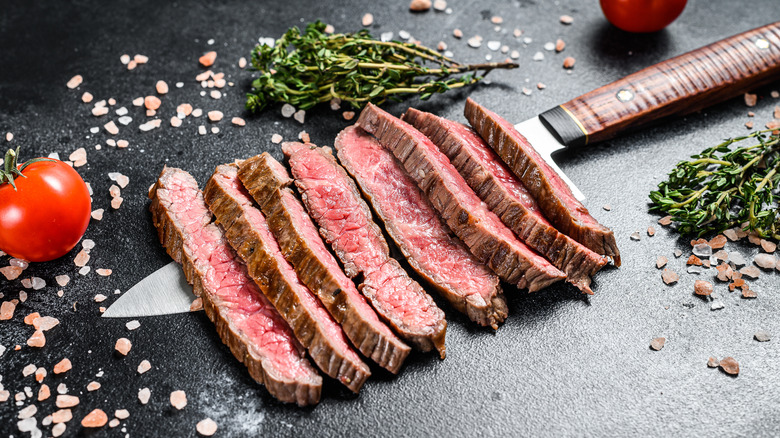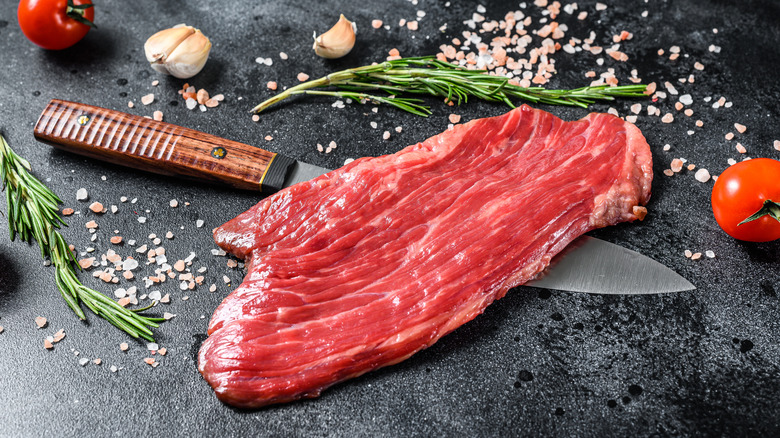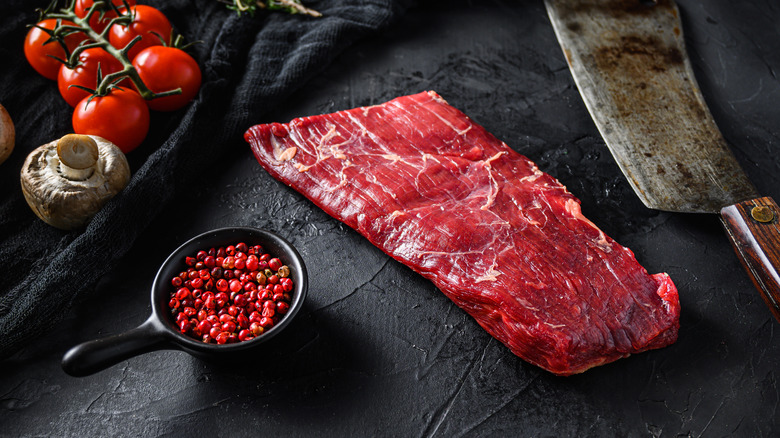10 Types Of Steak You Should Be Tenderizing
Everyone deserves to indulge in a quality, properly cooked, juicy steak once in a while. A good steak is one of the indisputable pinnacles of the world of food, an astounding testament to the beauty of well-executed simplicity. Unfortunately, the more fat-marbled, large, or specially raised the beef, the more expensive it is, and this type of steakhouse-quality meat is not accessible to everyone. That does not mean you cannot recreate restaurant-level steaks in your own kitchen at a fraction of the cost.
Inherently, less expensive cuts of steak will be less naturally tender. Multiple factors contribute to the tenderness of a steak: the presence of equally distributed fat, smaller and relaxed muscle fibers, and, most importantly, how it is prepared and cooked. This is why steaks like ribeyes or filet mignon are better left undisturbed by a meat mallet, as their soft and delicate structure can be ruined.
If you do find yourself a couple of good-looking steaks at your local grocer and decide to treat yourself and your family to a steak night, you want to make sure the money you put towards the meal reaches its potential. No matter what steaks you bring home, they have the opportunity to be delicious. So, it is best to start by knowing which cuts of steak require tenderizing in the first place.
Flank steak
Essentially, what makes a cut naturally tough or tender all depends on where the cut of steak is found on the cow. So, muscles that are frequently exercised and made stronger through active use will be tougher than muscles that stay relaxed. Flank steak is a large, rectangular-shaped cut of beef taken from the area between the ribs and stomach. This muscle of the cow, the abdominal, is used whenever the cow turns its body, which, obviously, is very often. This is why flank steak has little to no fat content and its muscle fibers are very thick and pronounced.
If you are planning on cooking a flank steak, tenderizing it beforehand is an absolute must. Not only will the extra care during preparation help yield a better-tasting steak, but it will also allow you to cook the steak to a higher temperature if that is your personal preference. Otherwise, the flank steak will be very chewy and tough if it exceeds a medium-rare interior.
The easiest way to tenderize flank steak is by pounding it with a meat mallet, as well as generously seasoning it with salt. Flank steak is also a great vehicle for marinades, which will also help with tenderization.
Skirt steak
Skirt steak is very similar to flank steak in that they both are cut from the same area of the cow; however, skirt steaks are cut directly below the rib, just before the flank cut begins. Although this part of the cow gets a good amount of exercise as well, skirt steak does come with a decent amount of fat and is much thinner than flank steaks. These characteristics do make for a more tender steak, but tenderizing skirt steak yourself is still well worth it because the thick muscle fibers are difficult to break down through cooking.
There are also two different sections of the skirt, the inner and outer skirt. You are unlikely to find outer skirt at a supermarket or butcher: it's more tender and uniform in shape but is typically sold to professional kitchens. So, most home cooks have to settle for the inner skirt. However, skirt steaks are a great cut to marinate — the longer the better, as always. Generous amounts of salt and a thorough pounding will help break down its thick muscle fibers and help the steak better absorb any marinade. It'll also not constrict as much when it hits the heat.
Tri-tip steak
Tri-Tip is one of the most underrated cuts of steak. As you probably guessed, the tri-tip has a triangular shape. It's also larger than many cuts, and there are only two cuts of tri-tip per cow. This may mislead some into thinking tri-tip is expensive, but it is actually very accessible, the reason being its location on the cow.
Tri-tip is cut from the bottom sirloin, a region of the sirloin primal that is tough and inexpensive, however, this cut actually has a decent amount of fat on it along with its thick muscle fibers. Up until the 1950s, tri-tip was normally set aside by butchers to be ground and sold as burgers patties or just regular ground beef. These muscle fibers do require some help breaking down and relaxing, so tenderizing is definitely encouraged.
Because tri-tips are bigger, they are a great steak option when entertaining a larger gathering. They can be cooked in the oven, in a slow cooker, or even on the grill. Once done cooking, tri-tip can easily be sliced into many pieces so everyone can take what they want. The uneven thickness of tri-tips may also cause it to cook unevenly, which can actually be a positive, as you don't have to worry about cooking it to everyone's liking. There can be multiple options of temperatures in this one cut of steak.
Sirloin tip steak
Sirloin steaks are one of the best cuts out there, but not every sirloin steak comes from the same muscle (and some are better than others). The sirloin steaks you will find on restaurant menus or with higher price tags are top sirloin, according to Beef, It's What's For Dinner. This means the steak is cut from the upper portion of the sirloin section of the cow. These are moderately fatty and are great steaks for grilling and individual portions.
The sirloin tip, on the other hand, actually doesn't come from the sirloin at all. Instead, it is cut from the edge of the round primal on the rear of the cow, says the beef advocacy site, and any cut of steak from the round will naturally be tougher due to the constant exercise that part of the cow gets. This translates to less expensive steaks because the meat is leaner and less tender, so the cuts require extra attention before cooking.
The sirloin tip can be purchased in individual steaks or as the whole sirloin tip roast. The single sirloin-tip steaks will definitely require some pounding and generous salt. It also works well with a tenderizing steak marinade recipe. The whole sirloin-tip roast is a more accessible option for slow cooking. This cut is a great option for dicing into a stew or carved into thin slices for fajitas or tacos, both of which will help improve the tenderness of the cut.
Top-round steak
Another cut of steak from the round primal is the top round. These are cut from the upper portion of the round, which means it is one of the leanest cuts of steak and quite tough. Top rounds are quite common in grocery stores, but they are often sold under the name London Broil, so if you are unsure when shopping, just remember that the two are interchangeable. Also, cube steak is another product that is the same as top round. Cube steaks are individually cut from the top round and are pre-tenderized, but this does mean you shouldn't further treat it yourself.
Top-round steaks are uniform in thickness and are very long, rectangular-shaped cuts of beef. Like sirloin tip, top-round steaks are a great option for dicing into pieces and putting into a beef stew; however, top sirloin can be grilled and shared with a crowd as long as you tenderize it thoroughly. This means a thorough pounding with a meat mallet, generous salting, and closely monitoring its temperature when cooking. If this cut exceeds 130 degrees Fahrenheit, any tenderness it had will most likely be cooked away.
Eye-of-round steak
Eye-of-round is another inexpensive cut from the round and is a very underrated cut of steak in general. Eye-of-round steaks can be purchased as individual cuts or as a whole roast, the latter of which is an economical alternative to something like a standing rib roast or a whole beef tenderloin. No matter what form your eye-of-round steak comes in, it will basically have zero fat on it. This lean cut is very flavorful, but it is more difficult to cook and tenderize.
The essential rules for cooking eye-of-round cuts are temperature and pace. The steaks need to be cooked at a low temperature over an extended period of time. Searing over high heat the way you would a ribeye or New York strip will only yield a very tough piece of meat.
This is not to say that the eye of round steaks is only meat suitable for the slow cooker or beef stew. The eye-of-round roast is very tasty if roasted much more gradually, with the only intense heat coming either before or after it comes out of the oven to accomplish a crusty exterior. Again, cheap and delicious should never be perceived as mutually exclusive. With the right measures taken, eye-of-round steaks can be just as satisfying as any other.
Chuck-eye steak
The next cut of steak on this list comes from a different primal cut on the cow: the chuck primal. This is the shoulder area of the cow between the ribs, leading up to the neck, according to Food Fire Friends. The chuck-eye steak, in particular, is found directly against the ribs, adjacent to the ribeye cut. According to the site, chuck eye steaks are cut from the fifth rib of the cow, which correlates to a fat content relative to that of the ribeye.
Chuck-eye steaks are not quite as flavorful, as this fat content is not as equally dispersed, but they are one of the more flavorful cuts from the chuck primal. The closer toward the neck, the leaner and tougher a steak will be. Because chuck eye steaks come from further toward the middle of the cow at the back end of the chuck primal, the muscle is more relaxed and fatty.
While this fat content does translates to a more tender and flavorful steak, chuck eyes are still not on the same level as ribeyes. They are simply a very accessible alternative. So, this means some extra tenderizing will help a chuck eye reach that heightened level and get you the best bang for your buck.
Flat-iron steak
Omaha Steaks explains that researchers at the University of Nebraska and the University of Florida located a completely new cut of steak in the chuck primal despite popular belief that the section had too much sinew and connective tissue to be sold as a steak. The flat iron steak has grown in popularity since its discovery and is now one of the best-tasting, economical alternative cuts available.
You may have heard of the top blade cut of steak before. Well, flat irons are cut out of the top blade, which is held together by a thick piece of connective tissue, but on the other side is a wonderfully marbled, even cut. This is where the flat iron comes from.
Despite only two flat-iron steaks being available from each cow, they remain at quite an accessible price point; however, you still want your steak to be the best it can be no matter how much you pay for it. While flat iron steals are well-marbled and have uniform thinness throughout, tenderizing them yourself will bring this cut to a whole new level. Flat irons are a very unique cut and suitable for subbing in for flank or skirt steak, as it takes very well to marinades, and is best cooked swiftly over high heat.
Merlot steak
Merlot steak is probably a cut you have never heard of before. This is the only cut of steak on this list to come from the shank portion of the cow, the portion including its thighs and hind legs, according to Crowd Cow. Merlot steaks are cut from the back end of the hind legs, an area that obviously gets a lot of exercise.
Merlot steaks are very lean and very thin, so tenderizing goes a long way toward a juicy final product. These cuts are most comparable to flank steaks, as their leanness and long rectangular shape make them very similar. Merlot steaks aren't as fibrous. The muscle grains are much finer and more easily broken down; this makes them a great steak to marinate and blast with heat on the grill. Although this cut is very lean, it can easily be made tender and juicy.
Plus, merlot steaks are very cheap because they come from the shank. Meat on the shank of the cow is usually used for ground beef or the entire primal is sold whole. Therefore, any cut from the shank is very inexpensive, despite this particular cut's versatility, flavor, and convenience.
Bavette steak
Bavette steak, or flap steak, is one of the unsung heroes of the cow. This cut is also known as the butcher's cut because butchers will often reserve it for themselves. The name "bavette" comes from the French word for "bib." This is because of the cut's location on the cow: the bottom sirloin, between the sirloin, short loin, and flank steak. This point is located deeper inside the body of the cow, making bavette have an excellent meat-to-fat ratio.
Essentially, bavette steak is a heightened version of the flank steak. It has the same shape, versatility, and general low cost, without the thick muscle fibers and a far greater amount of fat. Despite being well-marbled, bavette steaks are often uneven in thickness, so a swift pounding with a meat mallet will not only help it cook evenly, but it will also bring its tenderness to new heights.
Bavette steak is not as uncommon as you may think. It is definitely a rare find at a supermarket, but a good butcher shop should have some available — as they haven't already cooked it up themselves.
